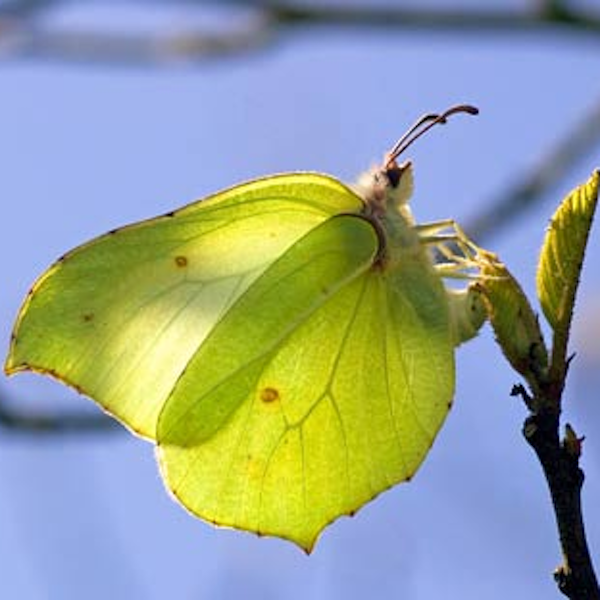
This project, in partnership with the Sheffield and Rotherham Wildlife Trust, aims to increase the local Brimstone butterfly population by inviting people to plant the butterfly’s larval host plant, Common Buckthorn, in their gardens and other green spaces.
You’ll need a 1.5 metre x 1.5 metre x 1.5 metre space available for each plant.
Please note, orders for Buckthorn plants for 2021 are now closed.
The Brimstone Butterfly
The Brimstone butterfly is bright yellow in colour, large, and is hard to mistake for anything else in the UK. Adults hibernate over winter, often hidden under Ivy leaves. They emerge in early spring, usually on warm days in February to April, and are usually seen flying fast and direct, as if on a mission to somewhere.
After mating, the female lays her eggs on Buckthorn, and the eggs usually hatch within 10 days, depending on the temperature.
The caterpillar feeds on the leaves of the Buckthorn plant over a period of one to two months usually in May and June, before pupating, and emerging as an adult butterfly in late July and August, when they are often seen nectaring on plants such as Thistle. The cycle then begins again, with the adults hibernating over winter.
Buckthorn
There are three native Buckthorn species in the UK, namely Common Buckthorn (Rhamnus cathartica), Alder Buckthorn (Rhamnus frangula) and Sea Buckthorn (Hippophae rhamnoides).The Brimstone butterfly lays its eggs on the first two of these, exclusively.
Alder Buckthorn only tends to thrive on waterlogged acidic soils, so for most gardens and sites, the best plants to buy to attract the Brimstone butterfly is Common Buckthorn, which is also sometimes known as “Purging Buckthorn.” Common Buckthorn has small yellow/green flowers in May, which when pollinated, turn into 6-10mm diameter purple/black berries in the autumn.
If you want to let Common Buckthorn grow, completely unconstrained, it can grow into a small sized tree, with a height of 6 metres to 7.5 metres. However, it can be pruned quite happily in late winter, to keep it smaller.
To attract the Brimstone butterfly to lay eggs, all you need is a 1.5 metre x 1.5 metre x 1.5 metre space for each plant.
The aim of the initiative
The aim of this Sheffield and Rotherham initiative is to demonstrate that very small practical steps, such as the planting of a larval host plant, can have large demonstrable impacts.
GDPR Statement
The initiative is being run by Nether Edge and Sharrow Sustainable Transformation (NESST) in partnership with Sheffield and Rotherham Wildlife Trust (SRWT). The information you submit via the request form, and subsequently, will be held for a maximum of a year by both NESST and SRWT, and will then be deleted.